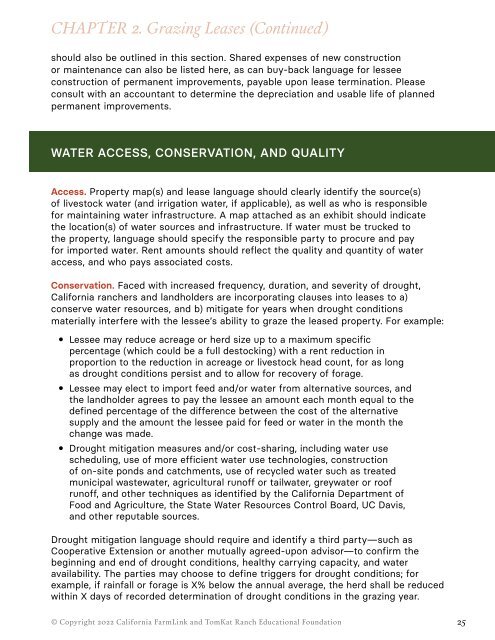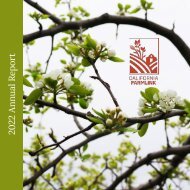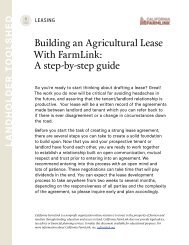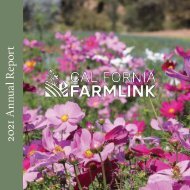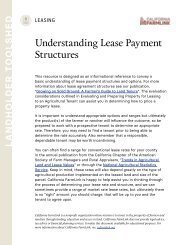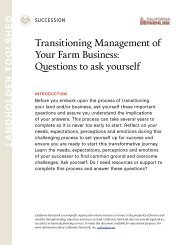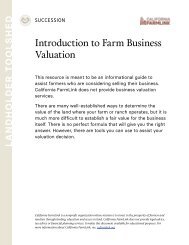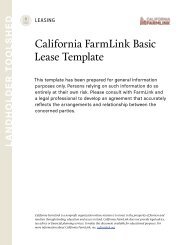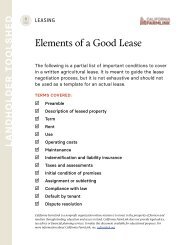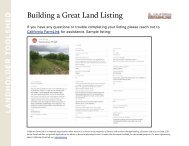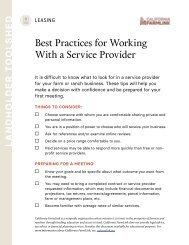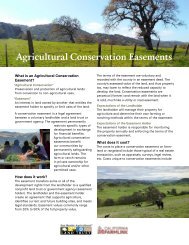Guide to Regenerative Grazing Leases: Opportunities for Resilience
California FarmLink and TomKat Ranch Educational Foundation teamed up to create this resource focused on land leases that support regenerative grazing practices. This guidebook aims to empower private, nonprofit, and public landholders, as well as easement-holders and grazing tenants.
California FarmLink and TomKat Ranch Educational Foundation teamed up to create this resource focused on land leases that support regenerative grazing practices. This guidebook aims to empower private, nonprofit, and public landholders, as well as easement-holders and grazing tenants.
Create successful ePaper yourself
Turn your PDF publications into a flip-book with our unique Google optimized e-Paper software.
CHAPTER 2. <strong>Grazing</strong> <strong>Leases</strong> (Continued)<br />
MAINTENANCE AND IMPROVEMENTS<br />
There should be clear language outlining responsibilities <strong>for</strong> maintenance, repair, and<br />
replacement of existing infrastructure, constructing new improvements, and assigning<br />
these responsibilities <strong>to</strong> the landholder or lessee. This may be accomplished in a chart<br />
or directly in clause language. Infrastructure referenced in this section could include<br />
fencing, roads, water access and delivery sources, buildings, animal enclosures and<br />
other structures.<br />
A lessee with short-term tenure cannot be expected <strong>to</strong> take on substantial<br />
infrastructure repairs and maintenance, or <strong>to</strong> invest in permanent infrastructure.<br />
A longer lease term, on the other hand, or a lower lease rate, may justify greater<br />
maintenance responsibilities <strong>for</strong> the lessee. A landholder who shoulders most of the<br />
maintenance and improvements can justify a higher lease rate.<br />
?<br />
REMEMBER, should permanent infrastructure be required, and investment of that<br />
infrastructure falls <strong>to</strong> the lessee, the duration of the lease term must be at least the<br />
length of the usable life of the improvement, and/or account <strong>for</strong> a buy-back of the<br />
remaining value of the investment at termination.<br />
See UC ANR’s <strong>Guide</strong> <strong>to</strong> Lives<strong>to</strong>ck <strong>Leases</strong> <strong>for</strong> Annual Rangelands <strong>for</strong> a sample table<br />
outlining a landholder’s and lessee’s responsibilities <strong>to</strong> construct and maintain<br />
infrastructure as part of a grazing lease.<br />
Permission and responsibility <strong>for</strong> new improvements and infrastructure are also<br />
specified in this section. Permission <strong>for</strong> the lessee <strong>to</strong> construct improvements such<br />
as corrals, fencing, roads, and structures should be specified and consistent with<br />
the length and terms of the lease.<br />
Maintenance responsibilities <strong>for</strong><br />
lessee-constructed improvements<br />
generally lie with the lessee.<br />
Construction of cross fencing, <strong>for</strong><br />
example, may improve rangeland<br />
health and can qualify <strong>for</strong> NRCS<br />
cost-share funds. Lessees require<br />
sufficient tenure <strong>to</strong> qualify <strong>for</strong><br />
such funds, so the terms of their<br />
application, use, and reimbursement<br />
should be detailed in the lease. If the<br />
landholder is expected <strong>to</strong> complete<br />
an improvement during the term of<br />
the lease or prior, the improvement<br />
Brittany Cole Bush, Shepherdess Land & Lives<strong>to</strong>ck Co.<br />
© Copyright 2022 Cali<strong>for</strong>nia FarmLink and TomKat Ranch Educational Foundation<br />
24


